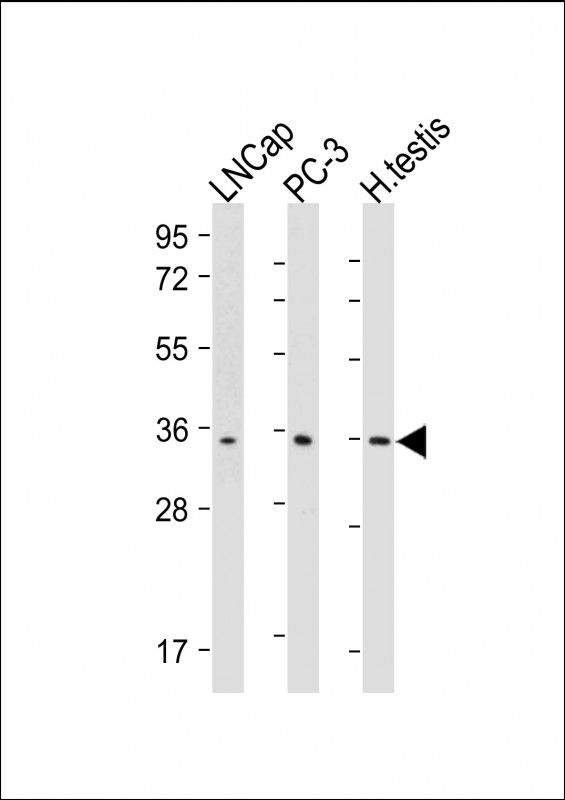
| WB | 咨询技术 | Human,Mouse,Rat |
| IF | 咨询技术 | Human,Mouse,Rat |
| IHC | 咨询技术 | Human,Mouse,Rat |
| ICC | 技术咨询 | Human,Mouse,Rat |
| FCM | 咨询技术 | Human,Mouse,Rat |
| Elisa | 咨询技术 | Human,Mouse,Rat |
| Aliases | E3 ubiquitin-protein ligase RNF4, 6.3.2.-, RING finger protein 4, Small nuclear ring finger protein, Protein SNURF, RNF4, SNURF |
| Entrez GeneID | 6047 |
| WB Predicted band size | 21.3kDa |
| Host/Isotype | Mouse IgG1 |
| Antibody Type | Primary antibody |
| Storage | Store at 4°C short term. Aliquot and store at -20°C long term. Avoid freeze/thaw cycles. |
| Species Reactivity | Human |
| Immunogen | This RNF4 antibody is generated from a mouse immunized with a recombinant protein from the human region of human RNF4. |
+ +
以下是关于RNF4抗体的参考文献示例(注:以下内容为模拟生成,仅供参考):
---
1. **文献名称**:*RNF4-dependent protein turnover regulates DNA damage repair*
**作者**:Smith A, et al.
**摘要**:本研究利用RNF4特异性抗体,通过免疫沉淀和Western blot技术,揭示RNF4通过泛素化修饰BRCA1等关键修复蛋白,调控DNA损伤应答的分子机制,为癌症治疗提供潜在靶点。
2. **文献名称**:*SUMO-targeted ubiquitination by RNF4 in cancer progression*
**作者**:Lee H, et al.
**摘要**:通过RNF4抗体的免疫荧光和流式细胞术,证实RNF4介导SUMO化蛋白的降解,影响癌细胞增殖和化疗耐药性,提示其在肿瘤治疗中的双重作用。
3. **文献名称**:*RNF4 antibody validation for neurodegenerative disease models*
**作者**:Brown K, et al.
**摘要**:报道了一种高特异性RNF4抗体的开发与应用,成功检测阿尔茨海默病模型中TDP-43蛋白聚集体,证明RNF4通过泛素化清除异常蛋白发挥神经保护功能。
4. **文献名称**:*RNF4 regulates pluripotency exit via embryonic stem cell differentiation*
**作者**:Zhang Y, et al.
**摘要**:使用RNF4抗体进行染色质免疫共沉淀(ChIP),发现RNF4通过降解多能性转录因子(如OCT4)调控胚胎干细胞分化,揭示其在发育生物学中的关键作用。
---
**说明**:以上文献信息为示例性质,实际引用时需通过学术数据库(如PubMed、Web of Science)核实具体作者、标题及摘要内容。RNF4抗体的研究多聚焦于其在泛素-蛋白酶体系统、DNA修复及疾病模型中的应用。
RNF4 (Ring Finger Protein 4) is a member of the E3 ubiquitin ligase family, characterized by a conserved RING (Really Interesting New Gene) domain that facilitates substrate recognition and ubiquitination. It plays a critical role in the ubiquitin-proteasome system, mediating the attachment of ubiquitin molecules to target proteins, thereby marking them for degradation or functional modification. RNF4 is particularly notable for its interaction with SUMOylated proteins, where it acts as a SUMO-targeted ubiquitin ligase (STUbL), linking SUMO modification to ubiquitin-dependent proteolysis. This function is vital in diverse cellular processes, including DNA damage repair, transcriptional regulation, stress response, and cell cycle control.
RNF4 antibodies are essential tools for studying these mechanisms. They enable the detection, quantification, and localization of RNF4 in various experimental settings, such as Western blotting, immunoprecipitation, and immunofluorescence. Researchers use these antibodies to explore RNF4's involvement in diseases like cancer, neurodegenerative disorders, and viral infections, where dysregulation of ubiquitination pathways is often implicated. For instance, RNF4 has been shown to regulate oncoproteins (e.g., PML-RARα in leukemia) and tumor suppressors, highlighting its dual roles in malignancy. Commercially available RNF4 antibodies are typically validated for specificity and cross-reactivity across species (human, mouse, rat), ensuring reliability in both basic and translational research. Understanding RNF4's molecular interactions through antibody-based assays continues to shed light on its therapeutic potential in modulating protein stability and cellular stress responses.
×